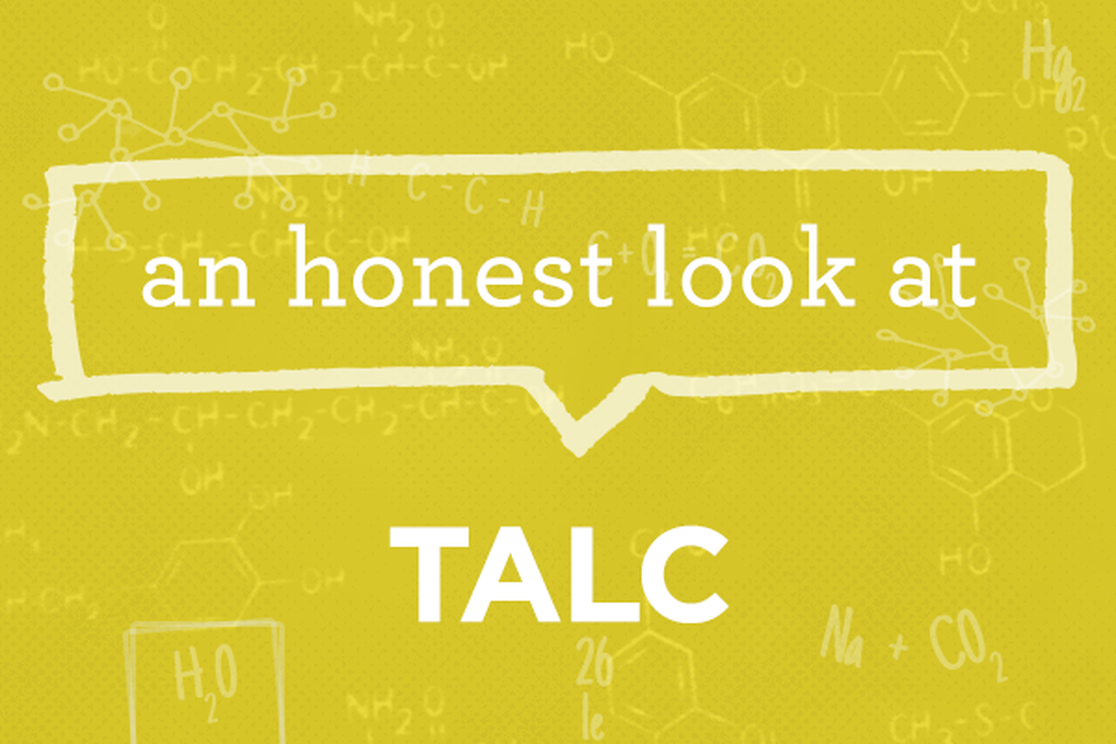This is part of our ongoing series helping consumers better understand chemicals, chemistry, and product formulations. We translate the science, bust the myths, and give you an honest assessment, so you can make informed choices for your family!
Ingredient:
Talc
What it is:
Talc is a naturally occurring mineral that’s translucent and pearly in appearance. It’s also the softest mineral, so it’s typically crushed into white powder (“talcum powder”) – the form most people are familiar with.
What it does:
Talc is used in bath and body products (i.e., baby powder, toothpaste, and deodorants), ceramics, paints, paper, and even as an excipient in medications and as a food additive (1). But for our purposes today, we’re focusing on its use in cosmetics and certain personal care products. In this category of products, talc is added because:
- the soft particles adhere to skin easily, but it’s also easily washed off;
- it absorbs oils and moisture on the skin to prevent friction and irritation (1-3); and,
- it acts as an astringent on skin (1,4).
Why we’re featuring it today:
Talc is included in our Honestly Free Guarantee because it may pose risks to human health — The Honest Company does NOT use it (ever!) — and we want to shed light on why you may not want to either.
Talc and asbestos often occur naturally in close proximity, meaning talc can be contaminated with asbestos – a known carcinogen (5). To address this risk, manufacturers in places like the EU and United States now carefully select mining sites to avoid this cross-contamination and/or refine the final product to eliminate any traces of asbestos. (Talc imported from other countries may still be contaminated.) Due to public concern, the U.S. FDA tested talc samples from raw material suppliers (they requested them from 9 companies, but only 4 complied), as well as products containing talc (5). While none of the samples or products had asbestos contamination, the FDA still concluded: “The results were limited, by the fact that only four talc suppliers submitted samples and by the number of products tested. For these reasons, while FDA finds these results informative, they do not prove that most or all talc or talc-containing cosmetic products currently marketed in the United States are likely to be free of asbestos contamination (5).”
Regardless of the fact that we could technically source pure talc, evidence of the safety of talc (even asbestos-free) is fuzzy with some studies finding an increase in cancer risk and others finding no association (6).
Based on a comprehensive review of the evidence, the International Agency for Research on Cancer (IARC) – part of the World Health Organization (WHO) – classifies talc as follows:
- IARC classifies talc that contains asbestos as “carcinogenic to humans.”
- Based on the lack of data from human studies and on limited data in lab animal studies, IARC classifies inhaled talc not containing asbestos as “not classifiable as to carcinogenicity in humans.”
- Based on limited evidence from human studies, IARC classifies the perineal (genital) use of talc-based body powder as “possibly carcinogenic to humans (7).”
Given these risks, and the fact that safer alternatives are readily available (like corn starch found in our Organic Baby Powder), Honest products are always made without talc.
Want your home to be Honestly Free of talc?
Make your home a talc-free zone by reading the ingredients labels on cosmetics, body powders, toothpastes, deodorants, medications, and even foods. Yes, it’s that simple! Being an avid label reader is one of the most powerful ways to create a healthier home.
References:
- Talc: The Softest Mineral. (n.d.). Retrieved July 28, 2014, from http://geology.com/minerals/talc.shtml
- Farage, M. A., & Lennon, L. (2006). Products for vulvar hygiene. The Vulva, 217.
- Knapik, J. J., Reynolds, K. L., Duplantis, K. L., & Jones, B. H. (1995). Friction blisters. Sports Medicine, 20(3), 136-147.
- Lee, H. J. (2009). Use and risks of talc in public health. Korean Journal of Veterinary Public Health.
- U.S. Food and Drug Administration. Retrieved November 17, 2015, from http://www.fda.gov/cosmetics/productsingredients/ingredients/ucm293184.htm
- Talcum Powder and Cancer. (n.d.). Retrieved July 28, 2014, from http://www.cancer.org/cancer/cancercauses/othercarcinogens/athome/talcum-powder-and-cancer
- Carbon black, titanium dioxide, and talc. (2010). IARC Monographs on the Evaluation of Carcinogenic Risk to Humans. Retrieved November 17, 2015, from http://monographs.iarc.fr/ENG/Monographs/vol93/mono93.pdf
This post was revised as of 11/23/2015.
We aim to provide you with the most honest and credible information possible. This article was reviewed for accuracy by The Honest Team and was written based on sources that are linked at the bottom of the article.
blog_review_statement



